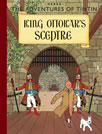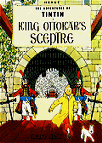King Ottokar's Sceptre

- Colour facsimile / 1947 partly re-drawn version. Hardback.

- Colour / 1947 partly re-drawn version
- Tintin © Hergé/Moulinsart.
Original French title
Tintin en Syldavie (serialised comic strip) / Le Sceptre d'Ottokar (album)
Publication history
First published in Le Petit Vingtième between 4/8 1938 and 10/8 1939.
Published in book form in 1939 in B/W, 106 pages.
Published in 1947 in full colour with some parts redrawn.
English edition
1958 - First published in Great Britain.
1990 - Mammoth (London). Colour. 62p. 30cm. Paperback. ISBN: 0749704667.
2008 - Egmont (London). Colour facsimile edition. 64p. 30x23cm. Hardback. ISBN: 9781405240734. Publication date: 2 June 2008.
Related link
First publication dates of The Adventures of Tintin
Plot
When Tintin and Snowy travel to Syldavia with Professor Alembick they find themselves mixed up in a rebel plot to depose the Syldavian king. If the king does not carry King Ottokar's sceptre in the royal procession he will lose his throne, and when the rebels manage to steal the sceptre the detectives Thomson and Thompson are called in. The situation is critical, but in an all-night chase over the mountains an adventurous trip by airplane, Tintin and Snowy come to the rescue. [Aaron Remick]
Trivia
- Cameos:
- Page 38, last frame: Hergé (in green uniform) is seen on the left hand side with E. P. Jacobs (in red top).
- Page 59, last frame: Hergé (right hand side of frame, in green), his wife Germaine (in purple), Jacobs (in front of Germaine, with monocle) and Van Melkebeke (left hand side near window, white bow tie).
- It is odd that Tintin does not notice that he has dropped the Sceptre as it is made of pure gold and must be somewhat heavy. [TT]
- The dictator is called Müsstler, which is a combination of Mussolini and Hitler. [BP, p.62]
- The text on the police station is in Cyrillic and translates to "GENDARMASKAIA". [TT]
- The original title of the book was going to be "Tintin en Syldavie" ("Tintin in Syldavia"). Hergé then changed it to "Le Sceptre d'Ottokar IV" ("The Sceptre of Ottokar IV"), but his publisher objected because it was less commercial, difficult to remember, and "almost impossible to pronounce" (in French). An agreement was eventually reached, and the title became "Le Sceptre d'Ottokar". [PA]
- Hergé wanted to have a colour double-spread of the Battle of Zileheroum, but due to the cost required for such an idea, it was abandoned. [PA]
- The cover of the black and white edition of the book was going to have the sceptre and the armour printed in gold, with Tintin's hair yellow. However, Casterman wanted to colour Tintin's hair brown (like his raincoat) to keep the number of colours used for printing down to four. Hergé was very much opposed to this—"Tintin has always had fair hair, and it would be a commerical mistake to give him brown hair, and also make him less recognisble." Ultimately, the sceptre and armour was printed in yellow—like Tintin's hair. [PA]
- When a man tries to take Tintin's picture, the click of the camera is heard when Tintin is still on the landing of the stairs. But curiously, the photograph shows Tintin in the middle of the stairs. [ET]
- In frame 1 on page 6, there is an empty chair next to Tintin. The chair disappears in frames 2 and 4, but reappears in frame 5.
- On page 7, Tintin reads that Borduria conquered Syldavia in the 11th century, but the tourist brochure states that the year is 1195 (12th century).
- On page 30, frame 10, the fresco to the right hand side of the door features 5 figures. In the last frame of page 41, the same fresco shows 6 figures.
- Musstler, the villain of King Ottokar's Sceptre, does not appear in the story at all; reader Anthony Durrant wonders whether Hergé got this idea from Sir Arthur Conan Doyle's Sherlock Holmes novel, The Valley of Fear. [AD]
Title in other languages
- Arabic - Tantan wa-sawlajan al-malik Uttukar
- Basque - Ottokarren Zetroã
- Bengali - Ottokarer Rajdanda
- Breton - Bazh-roue Ottokar
- Catalan - El céptre d'Ottokar
- Chinese - China: 奥托卡王的权杖 (Aotuoka wang de quanzhang) / Hong Kong and Taiwan: 奧托卡王的權杖 (Aotuoka wang de quan zhang)
- Danish - Kong Ottokars scepter
- Dutch - De scepter van Ottokar
- Faeroese - tignarstavur ottokars
- Farsi/Persian - Asayi sihramiz
- Finnish - Kuningas Ottokarin valtikka
- French - Le Sceptre d' Ottokar
- Galician - O ciero de Ottokar
- German - König Ottokars Zepter
- Greek - To Skiptro tou Ottokap
- Hebrew - Sharvito shel Ottokar
- Hungarian - Ottokár jogara
- Icelandic - Veldissproti Ottokars konungs
- Indonesian - Tonkat raja Ottokar [Indira edition title] / Tongkat Ottokar [Gramedia edition title]
- Italian - Lo scettro di Ottokar
- Japanese - オトカル王の杖 Ottokar o no tsue
- Norwegian - Kong Ottokars septer
- Portuguese - O cètro de Otokar
- Serbo-Croatian - Skiptar kralja Otokara
- Slovenian - Otokarjevo Zezlo
- Spanish - El cetro de Ottokar
- Swedish - Kung Ottokars spira
- Turkish - Ottokar'in Asasi
- Vietnamese - Cùa vua Ottokar
- Welsh - Teyrnwialen Ottokar
